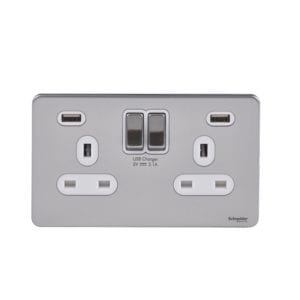 It is highly likely that we have all experienced times where our mobile device is running low on battery power and we urgently need to find a charging point. Since 2015 we have seen a change in technology with the majority now using USB (universal series bus), with options such as Lightening, Mini USB etc. or more recently wireless charging.
It is highly likely that we have all experienced times where our mobile device is running low on battery power and we urgently need to find a charging point. Since 2015 we have seen a change in technology with the majority now using USB (universal series bus), with options such as Lightening, Mini USB etc. or more recently wireless charging.
From the 1st of April 2020, in accordance with the Ecodesign Directive 2009/125/EC, there are new requirements coming into force for the use of external power supplies. In line with this change, all USB socket outlet manufacturers are required to manufacture products with a focus on efficiency of the charging device and publish active power efficiency levels in supporting information, such as user guides, online data sheets etc.
Inefficient products have the risk of shortening the lifecycle of the power outlet itself as well as creating a hazardous situation as a result of extreme overheating. So clearly products of the highest efficiency provide both the highest performance but the safest option.
Key factors of USB charging performance
1- Power level
The power level of a device is important when choosing the correct charging adaptor or socket.
Common sense suggests that:
• The higher the voltage, the less the power loss and heat dissipation
• The higher the current, the lower the charging time required
As USB is a DC power delivery system, optimisation of the cable length and width is also key. Considering these facts, today power levels can go up to 100W (4.62A at 19.5V) for laptops, 45W (2.25 at 20V) for tablets, and 18W (2A at 9V) for new smart phones.
2- Charging protocol
The power level is not the only factor to consider. There are different types of protocols which also have an impact, causing limitations.
Type of Protocols
A) Battery charging 1.2
• Low power devices (5V, max 150mA)
• High power devices (5V, max 1.5A)
B) Proprietary protocols
• Developed by phone companies for their own devices (Apple 2.4A, Samsung 2.1A)
C) Quick charge defined by Qualcomm QC3.0
• Can be used with USB type A or C (3.6V to 20V, max 3A)
• From QC4.0, the protocol will align with power delivery
• More Android phones will be introduced with fast charging
D) Power delivery defined by USB-IF organisation 3.0
• Can be used with USB type C only (5V to 20V, max 5A)
• Apple and Google devices with fast charging
3- Charging cables and device age
The quality of charging cable affects charging time. Third party cables require longer to charge a device, and the lead and connections might heat up quickly, therefore creating risk.
When a mobile device is new, it is charged more efficiently since the battery capacity is high and the battery discharging rate is low. In contrast, when the device gets older the discharging rate becomes higher.
With a device that has a fast charging capability together with the highest battery capacity and a compatible charging cable, it can take just over two hours to fully charge using a 2.1A charger. With a 1A charger, it will take in excess of three hours to charge the same device from 0% to 100%.
4- Energy efficiency

One of the most important factors that we tend to neglect is the charger’s efficiency.
USB socket outlets are usually installed in walls, furniture or housings which can cause undesirable heating in the back box, enclosure or surrounding area, therefore making it difficult for them to perform efficiently.
Required efficiency levels, referred as active power efficiency, are clearly stated in the regulations (No 2019/1782 on External Power Supplies).
Low-cost USB chargers are likely to have a low level of efficiency below 75%. Schneider Electric devices have the highest efficiency, leading the USB charging market far ahead of the closest competition.



